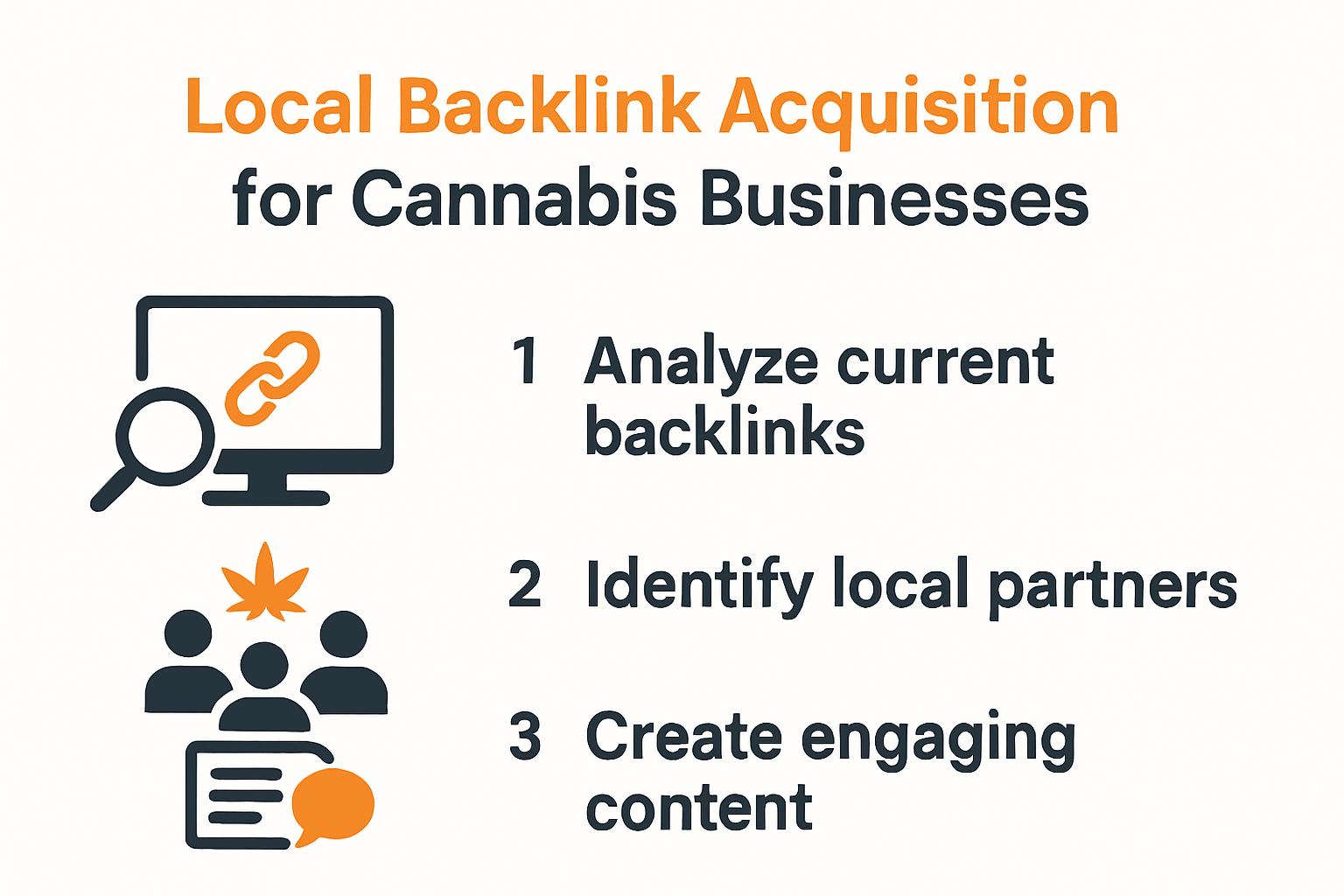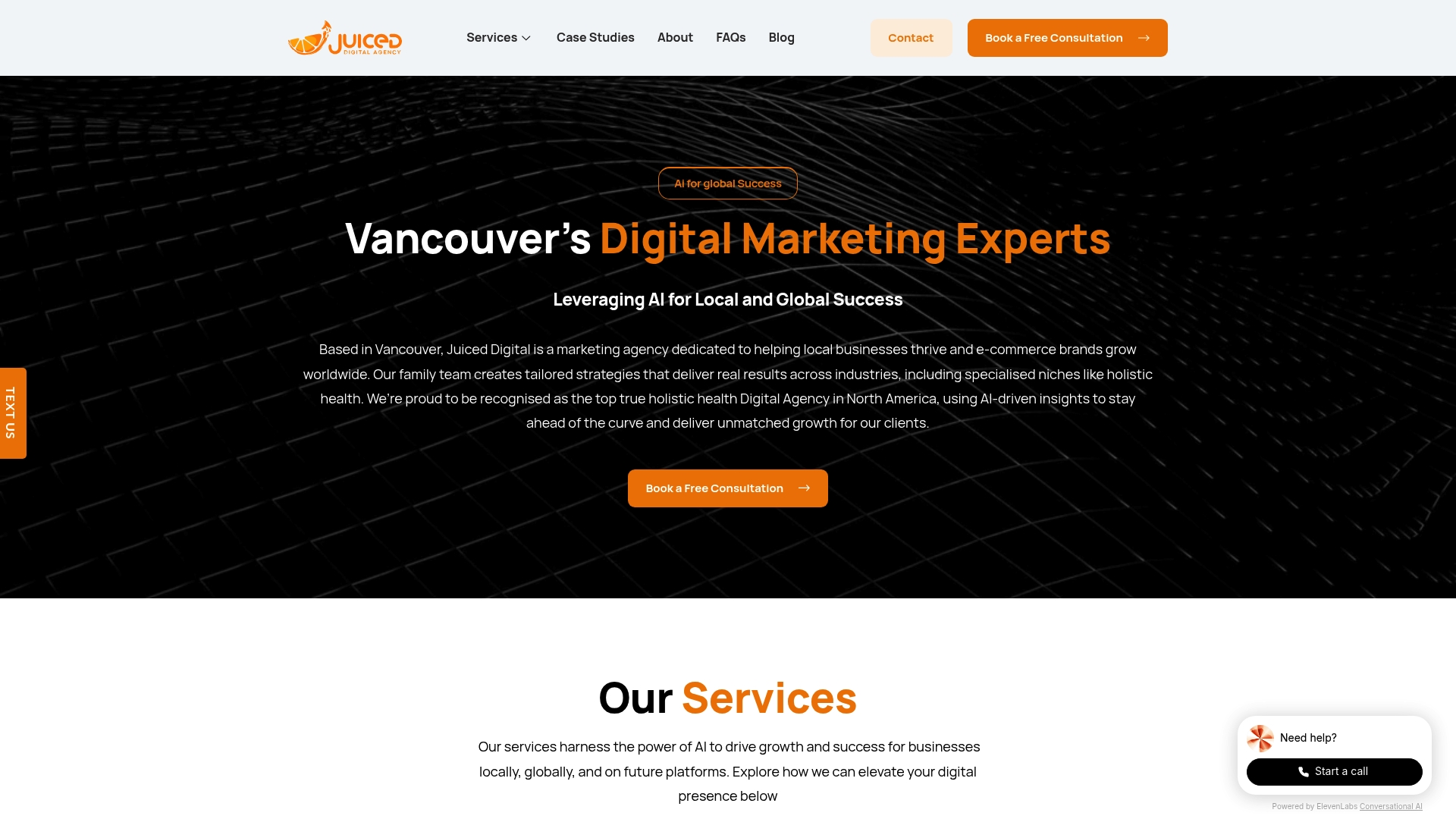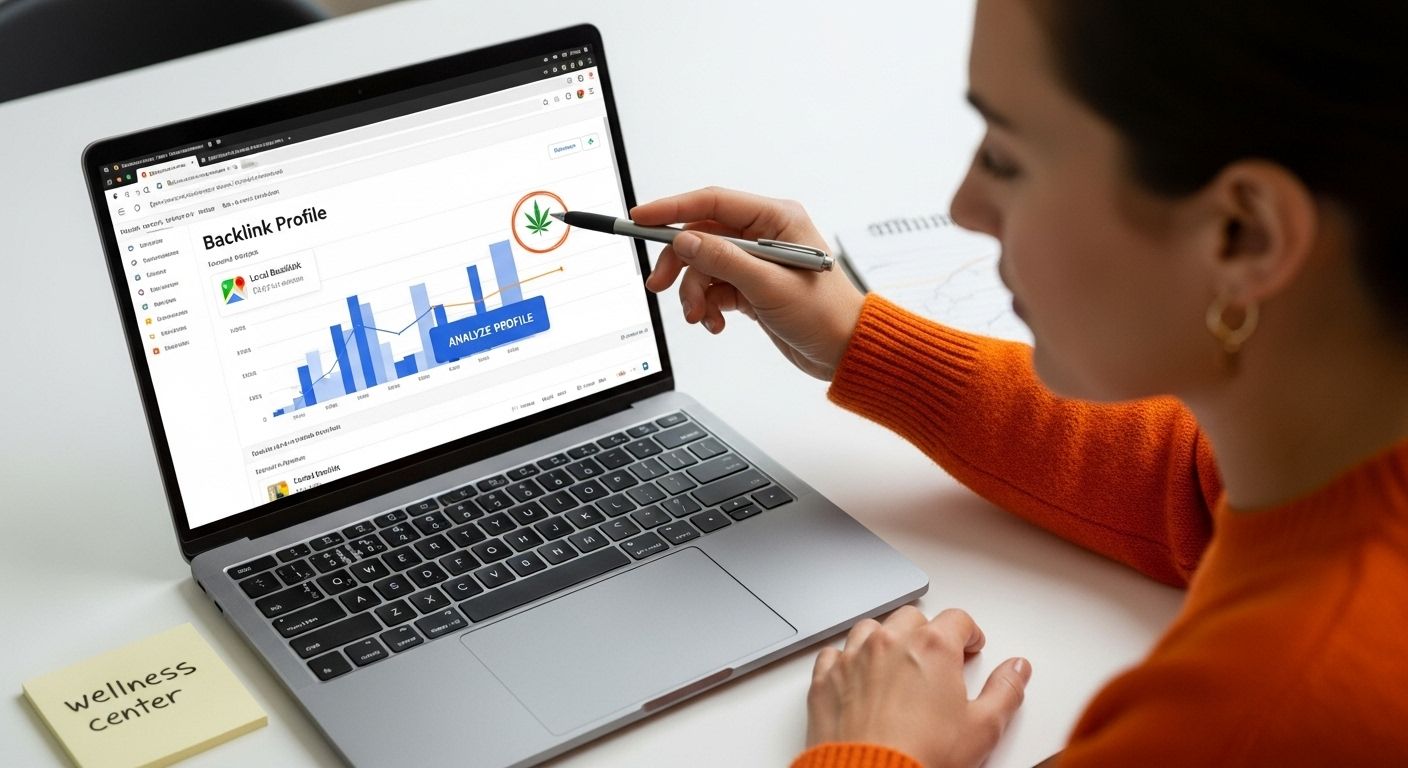Local backlinks can make or break your cannabis business online. One well-placed link from a trusted neighbor can drive 10 times more relevant traffic than dozens of random listings. Most people think the secret is simply collecting as many links as possible. The real advantage comes from building precise, local connections that Google—and your customers—actually trust.
Table of Contents
- Step 1: Analyze Your Current Backlink Profile
- Step 2: Identify Local Businesses And Influencers
- Step 3: Create Engaging Content To Attract Links
- Step 4: Reach Out To Local Partners For Collaboration
- Step 5: Monitor And Evaluate Your Backlink Success
Quick Summary
| Key Point | Explanation |
|---|---|
| 1. Analyze current backlink profile | Use tools like Google Search Console and Ahrefs to assess your existing backlinks and their quality. |
| 2. Identify local business partners | Map out local businesses that complement your cannabis brand for potential backlink exchanges and collaborations. |
| 3. Create engaging, valuable content | Develop high-quality content that addresses key industry pain points to attract links naturally and enhance authority. |
| 4. Personalize outreach to partners | Craft individualized messages for local businesses to foster genuine relationships and mutual value beyond link exchanges. |
| 5. Monitor backlink performance regularly | Use SEO tools to track backlink quality and effectiveness monthly, adjusting strategies based on what works best. |

Step 1: Analyze Your Current Backlink Profile
Before diving into local backlink acquisition for your cannabis business, you need a clear understanding of your current link landscape. A comprehensive backlink profile analysis serves as the strategic foundation for targeted link building efforts. Think of this step like taking a detailed snapshot of your website’s existing digital connections.
The first stage involves selecting robust analytical tools that can provide granular insights into your current backlinks. Google Search Console and Ahrefs are two powerful platforms that offer comprehensive backlink assessments. These tools will help you uncover critical details about your existing link portfolio, including total number of backlinks, referring domains, domain authority, and potential link quality issues.
As you begin your analysis, focus on several key metrics that reveal the health and potential of your current backlink profile. Examine the total number of backlinks, but more importantly, assess their quality. Not all backlinks are created equal. Look for links from reputable, relevant websites within the cannabis, local business, and wellness industries. Pay special attention to domain authority, relevance, and geographical proximity of linking websites.
Identify potential weaknesses in your current backlink strategy by flagging low-quality or potentially harmful links. Some red flags include links from spammy websites, irrelevant domains, or sites with questionable reputation. Most professional SEO tools provide a “toxic link” report that helps you pinpoint these problematic connections.
Learn more about strategic link building techniques that can transform your current backlink landscape. By thoroughly understanding your existing link profile, you create a strategic roadmap for future local backlink acquisition.
Verification of a successful backlink profile analysis includes:
- Comprehensive list of all current backlinks
- Clear understanding of link quality and domain authority
- Identification of potential link-building opportunities
- Removal or disavowal plan for toxic backlinks
Remember, this initial analysis is not about perfection but about establishing a baseline from which you can strategically improve your local backlink ecosystem.
Below is a checklist summarizing the verification criteria for a successful backlink profile analysis as discussed above. Use this table to ensure all critical aspects of your analysis are complete before moving on.
| Verification Item | Description |
|---|---|
| List of Current Backlinks | Comprehensive record of all your active backlinks |
| Link Quality & Domain Authority | Assessment of authority and relevance for each backlink |
| Identify Link Opportunities | Recognition of areas and sites for new link-building |
| Toxic Links Removal Plan | Strategy for removing or disavowing spammy or harmful links |
| Baseline Established | Clear starting point for ongoing improvement |
Treat it as a diagnostic tool that reveals both your strengths and opportunities for growth in the competitive cannabis digital marketing landscape.
Step 2: Identify Local Businesses and Influencers
Building a robust local backlink strategy for your cannabis business requires strategic networking and relationship development within your community. This step transforms your digital marketing approach from isolated tactics to a collaborative ecosystem of local partnerships.
Start by mapping out potential local business connections that align with your cannabis brand. Look beyond direct competitors to complementary businesses such as wellness centers, holistic health practitioners, local fitness studios, and organic food stores. These businesses often share similar customer demographics and might be open to mutually beneficial backlink exchanges.
Explore advanced networking techniques that can help you establish meaningful connections. Your goal is to create genuine relationships that naturally evolve into digital collaborations. Research local businesses through Google Maps, chamber of commerce directories, and industry-specific networking platforms to compile a comprehensive list of potential partners.
Influencer identification requires a nuanced approach in the cannabis industry. Focus on micro-influencers who have authentic connections within wellness, health, and lifestyle niches. These individuals often have highly engaged local audiences and understand the specific content guidelines surrounding cannabis promotion. Use platforms like Instagram, LinkedIn, and local social media groups to discover influencers who resonate with your brand’s values and target market.
When reaching out to potential partners, personalize your communication. Demonstrate genuine interest in their business, highlight potential mutual benefits, and propose specific collaborative opportunities. Whether it is guest blog post exchanges, collaborative content creation, or cross-promotional events, your approach should emphasize value creation over transactional link building.
Verification of successful local business and influencer identification includes:
- Comprehensive spreadsheet of potential local business partners
- List of relevant micro-influencers in your geographic and industry niche
- Initial contact strategy for each identified connection
- Clear value proposition for potential collaboration
Remember that building these connections is a relationship-driven process. Patience, authenticity, and consistent engagement are key to transforming initial contacts into long-term digital marketing partnerships that enhance your local backlink strategy.
Step 3: Create Engaging Content to Attract Links
Content creation is the magnetic force that draws high-quality backlinks to your cannabis business website. Your content must transcend basic information and become a valuable resource that other websites want to reference and share.
Focus on developing comprehensive, authoritative content that addresses specific pain points within the cannabis industry. This means creating in-depth guides, research-backed articles, and unique insights that provide genuine value to readers. Consider producing content that explores topics like cannabis wellness, local regulatory updates, emerging industry trends, or educational resources about responsible cannabis consumption.
Learn advanced content strategies for organic growth that can transform your digital presence. Original research, expert interviews, and data visualization are powerful techniques that naturally attract backlinks. Local cannabis businesses can differentiate themselves by creating content that speaks directly to community needs and demonstrates deep understanding of regional cannabis landscapes.
Multimedia content significantly increases link attraction potential. Develop resources like infographics explaining cannabis legislation, video tutorials about product usage, or interactive maps showing local cannabis regulations. These formats are inherently shareable and provide visual complexity that encourages other websites to embed and link back to your original content.
When crafting content, prioritize accuracy, depth, and actionable insights. Your goal is to become the go-to resource in your local cannabis ecosystem. This means producing content that not only informs but also empowers readers with practical knowledge they cannot easily find elsewhere.
Verification of successful content creation includes:
- Comprehensive, well-researched content pieces
- Clear demonstration of unique perspective or original insights
- Engaging multimedia elements
- Potential for natural link generation
Remember that creating link-worthy content is a strategic process. Consistently producing high-quality, original content positions your cannabis business as an authoritative voice in the local digital landscape. Each piece of content is an opportunity to attract backlinks, build credibility, and expand your online visibility.
Step 4: Reach Out to Local Partners for Collaboration
Reaching out to local partners transforms your backlink strategy from passive waiting to active relationship building. Effective collaboration is about creating genuine connections that provide mutual value beyond simple link exchanges.
Begin by crafting personalized outreach messages that demonstrate your understanding of each potential partner’s business goals. Generic templates fail where specific, thoughtful communication succeeds. Research each potential partner thoroughly, understanding their brand, audience, and potential intersection with your cannabis business. Your communication should highlight how a collaboration could benefit their organization, not just yours.
Discover strategic networking approaches that can elevate your partnership development. When approaching local businesses, wellness centers, medical practitioners, or complementary industry professionals, emphasize shared values and potential collaborative content opportunities. This might include joint webinars, cross-promotional blog posts, local event sponsorships, or expert interview exchanges.
Digital outreach requires a multilayered approach. Utilize professional networking platforms like LinkedIn, attend local business events, and leverage chamber of commerce connections. Email remains a critical communication tool, but personalization is key. Your initial contact should feel like the start of a relationship, not a transactional link request.
Consider developing collaborative content that provides genuine value. This could include local health and wellness guides, community education resources about responsible cannabis consumption, or research-backed articles exploring cannabis benefits. Such content naturally attracts backlinks while positioning your business as a knowledgeable, community-focused organization.
Verification of successful partner outreach includes:

- Comprehensive tracking of initial contact attempts
- Follow-up communication strategy
- Documented potential collaboration opportunities
- Initial agreements or memorandums of understanding
Remember that building local partnerships is a long-term strategy. Not every outreach will result in immediate backlinks, but each genuine connection expands your network and increases future opportunities. Patience, authenticity, and consistent value creation are your most powerful tools in developing a robust local backlink ecosystem.
Step 5: Monitor and Evaluate Your Backlink Success
Monitoring and evaluating your backlink strategy transforms raw data into actionable insights that continuously improve your cannabis business’s digital presence. Successful backlink management is an ongoing process of measurement, analysis, and strategic refinement.
Utilize comprehensive SEO tools like Ahrefs, SEMrush, and Moz to track your backlink performance meticulously. These platforms provide detailed analytics that go beyond simple link counting. Focus on metrics that truly matter: domain authority of linking websites, relevance of referring domains, anchor text diversity, and the potential referral traffic each backlink generates.
To help you select the right SEO tools throughout your local backlink process, the table below summarizes the recommended tools mentioned in this guide, their main uses, and key notes.
| Tool | Main Use | Key Notes |
|---|---|---|
| Google Search Console | Backlink analysis, toxic link identification | Free, good for tracking overall website health |
| Ahrefs | Comprehensive backlink profile, quality assessment | Paid, detailed analytics and domain authority |
| SEMrush | Backlink tracking and evaluation | Paid, useful for competitive analysis |
| Moz | Backlink analysis and monitoring | Paid, known for domain authority metric |
| Partner outreach and networking | Key for connecting with local businesses | |
| Google Maps | Identifying local business partners | Useful for mapping local opportunities |
Explore advanced backlink tracking techniques that can elevate your digital marketing strategy. Pay close attention to the quality of new backlinks, not just their quantity. A single high-authority local business or industry-specific website linking to you can be more valuable than dozens of low-quality links.
Establish a consistent monitoring schedule, ideally conducting a comprehensive backlink audit monthly. During these reviews, identify and categorize your backlinks. Recognize which local partnerships and content strategies are generating the most valuable connections. Look for patterns in successful link acquisitions and be prepared to double down on what works while abandoning less effective approaches.
Proactive link maintenance is crucial for long-term SEO health. Regularly check for and disavow toxic or spammy backlinks that could potentially harm your website’s search engine reputation. This involves using Google Search Console to identify potentially harmful links and using the disavow tool to signal to search engines that you do not endorse these connections.
Verification of successful backlink monitoring includes:
- Comprehensive monthly backlink performance report
- Identification of top-performing linking domains
- Clear strategy adjustments based on performance data
- Removal of toxic or low-quality backlinks
Remember that backlink success is not a destination but a continuous journey. Your local cannabis business’s digital authority grows through consistent, strategic, and intelligent link-building efforts. Treat each backlink as a relationship, not just a technical SEO metric, and your online presence will steadily strengthen.
Transform Your Cannabis Backlink Strategy With High-Performance SEO
Struggling to build trustworthy local backlinks in the highly-regulated cannabis industry? If your efforts to identify high-quality partners or remove toxic links are not generating the organic search growth you need, you are not alone. Most cannabis businesses face roadblocks with restricted advertising platforms, evolving search algorithms, and limited outreach opportunities. Achieving strong local visibility and genuine authority is harder than ever. That is why businesses turn to proven experts who use the latest strategies in effective SEO for cannabis and local businesses.

Ready to see measurable growth for your dispensary or e-commerce site? At Juiced Digital, we deliver ROI-driven link building and AI-powered SEO systems designed specifically for the cannabis and e-commerce sectors. Partner with a team that uses a proprietary network, advanced outreach, and tailored content to secure the quality backlinks you need right now. Visit our homepage to get started or explore more strategies for dispensaries and learn how you can drive organic rankings and revenue growth this month.
Frequently Asked Questions
How can I analyze my current backlink profile for my cannabis business?
To analyze your current backlink profile, use tools like Google Search Console and Ahrefs to assess the quality and quantity of your backlinks. Focus on metrics such as total backlinks, referring domains, and domain authority, as well as identifying any low-quality or toxic links that may harm your reputation.
What types of local businesses should I consider partnering with for backlinks?
Look for complementary businesses within the wellness and health sectors, such as wellness centers, holistic health practitioners, fitness studios, and organic food stores. These partnerships can help you build a robust backlink strategy and reach similar customer demographics.
What strategies can I use to create engaging content that attracts backlinks?
Develop in-depth guides, research-backed articles, and unique insights addressing relevant topics in the cannabis industry. Utilize multimedia content like infographics and videos to increase shareability and ensure your content is informative, accurate, and valuable to your audience.
How often should I monitor and evaluate my backlink success?
You should conduct a comprehensive backlink audit at least once a month to track your backlink performance. This includes assessing the quality of new backlinks, identifying top-performing linking domains, and disavowing any toxic links to maintain your website’s SEO health.
Recommended
- Backlink Building Tips for Cannabis and Ecommerce: 2025 Guide – Digital PR Expert | Digital Marketing & Search Leaders
- Advanced SEO Strategies for Cannabis and Local Businesses – Digital PR Expert | Digital Marketing & Search Leaders
- Effective Link Building Strategies for Cannabis & Local Stores 2025 – Digital PR Expert | Digital Marketing & Search Leaders
- Broken Link Building for Cannabis & Local Businesses 2025 – Digital PR Expert | Digital Marketing & Search Leaders




